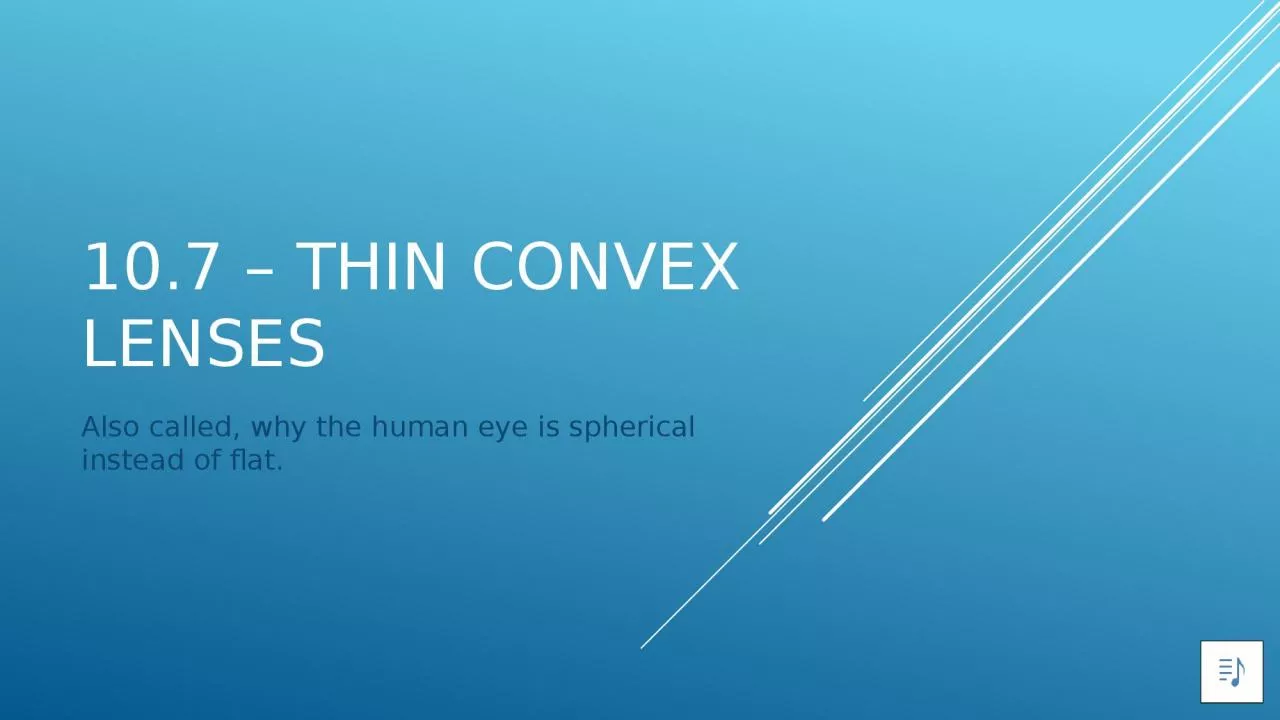

Also called why the human eye is spherical instead of flat Ever wondered Objectives WWBAT Describe how an image is formed by a thin convex lens Determine the location of image formation for a thin convex lens ID: 933216
Download Presentation The PPT/PDF document "10.7 – THIN CONVEX lenses" is the property of its rightful owner. Permission is granted to download and print the materials on this web site for personal, non-commercial use only, and to display it on your personal computer provided you do not modify the materials and that you retain all copyright notices contained in the materials. By downloading content from our website, you accept the terms of this agreement.
Slide1
10.7 – THIN CONVEX lenses
Also called, why the human eye is spherical instead of flat.
Slide2Ever wondered…?
Slide3Objectives
WWBAT…
Describe how an image is formed by a thin convex lens
Determine
the location of image formation for a thin convex lens
Determine the magnification of an image for a thin convex lensDetermine whether or not an image is upright or inverted for a thin convex lensDetermine whether an image is real or virtual for a thin convex lens
Slide4Image formation by refraction
in thin convex lenses
Convex:
bending outward
Thin convex lenses are also called biconvex or converging
Light rays from an object are refracted and converge to form a real image beyond the lens
Slide5Focal length
The focal length of a thin convex lens is the point beyond the lens where all head-on light rays converge when refracted
This is
not
where the image forms, however!
Slide6How to predict image formation for thin convex lenses
Questions to ask
Where does the image form?
Is the image upright or inverted (upside down)?
Is the image larger or smaller than the original image?
Slide7Ray Diagrams
for thin convex lenses
Slide8Ray Diagrams
for thin convex lenses
Slide9Ray Diagrams
for thin convex lenses
Slide10Ray Diagrams
for thin convex lenses
Slide11Ray Diagrams
for thin convex lenses
Check out the
PhET
Virtual Lab on the course website!
Slide12A tricky example…
Slide13A tricky example…
Slide14A tricky example…
Slide15An even trickier example…
Slide16The Five Cases
Image beyond 2F
Image at 2F
Image between
F and 2F
Image at FImage closer to lens than F
Real image
Inverted
Smaller
Real
image
Inverted
Same size
Real image
Inverted
Larger
No image forms
Virtual image
Upright
Larger
Slide17Check yourself #1
Slide18Check yourself #1
Slide19Math of image formation
Slide20Math of image formation
Possible Outcome
What it means
d
i
is negative
Virtual
image; image forms on same side of lens
h
i
or M is negative
Real image (inverted)
Slide21A 4.00-cm tall light bulb is placed a distance of 45.7 cm from a double convex lens having a focal length of 15.2 cm. Determine the image distance and the image size
.
Image Distance
Image Size
Image Distance
Image Size
Slide22A 4.00-cm tall light bulb is placed a distance of 45.7 cm from a double convex lens having a focal length of 15.2 cm. Determine the image distance and the image size
.
Image Distance
Image Size
Image Distance
Image Size
Slide23A 4.00-cm tall light bulb is placed a distance of 45.7 cm from a double convex lens having a focal length of 15.2 cm. Determine the image distance and the image size
.
Image Distance
Image Size
Image Distance
Image Size
Slide24A 4.00-cm tall light bulb is placed a distance of 45.7 cm from a double convex lens having a focal length of 15.2 cm. Determine the image distance and the image size
.
Image Distance
Image Size
Real
image, inverted, smaller than original
Image Distance
Image Size
Slide25You Try
4.00-cm
tall light bulb is placed a distance of 8.30 cm from a double convex lens having a focal length of 15.2 cm. (NOTE: this is the same object and the same lens, only this time the object is placed closer to the lens.) Determine the image distance and the image size
.
Slide26You Try
4.00-cm
tall light bulb is placed a distance of 8.30 cm from a double convex lens having a focal length of 15.2 cm. (NOTE: this is the same object and the same lens, only this time the object is placed closer to the lens.) Determine the image distance and the image size
.
Image Distance
Image Size
Virtual image, upright,
larger than original
Image Distance
Image Size
Slide27Objectives
WWBAT…
Describe how an image is formed by a thin convex lens
Determine
the location of image formation for a thin convex lens
Determine the magnification of an image for a thin convex lensDetermine whether or not an image is upright or inverted for a thin convex lensDetermine whether an image is real or virtual for a thin convex lens
Slide28Still want more?
Extra resources on the website about how the eye works!